Traditional Chinese Medicine Market Size
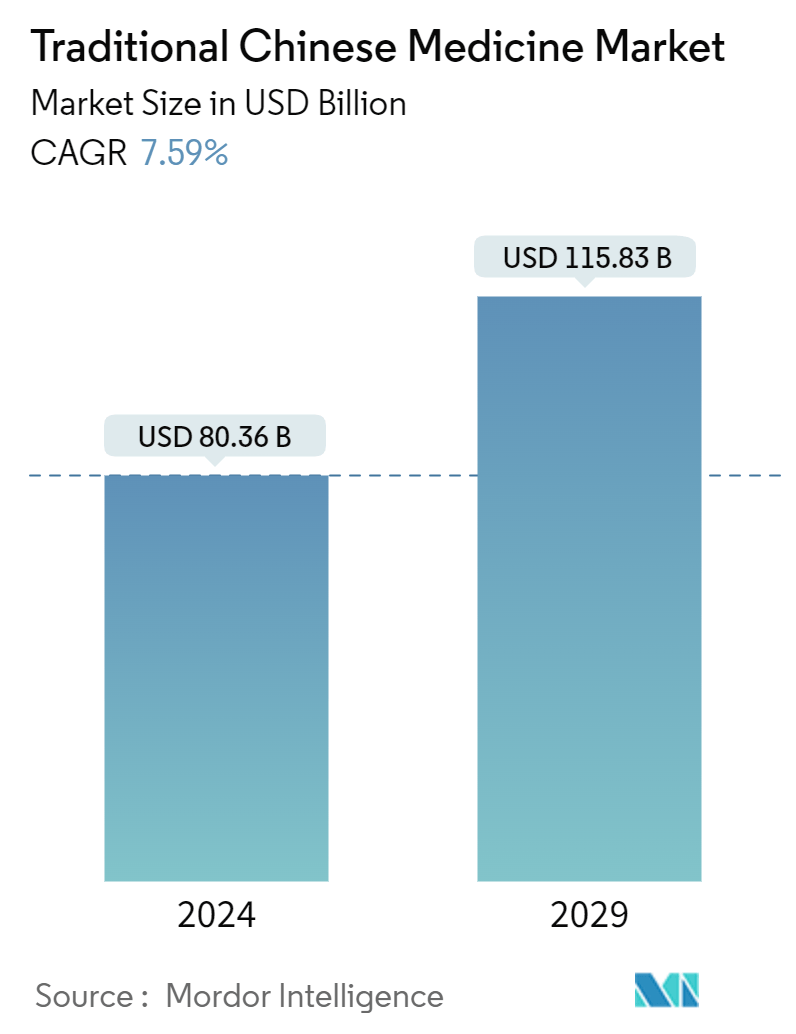
| Study Period | 2019 - 2029 |
| Market Size (2024) | USD 80.36 Billion |
| Market Size (2029) | USD 115.83 Billion |
| CAGR (2024 - 2029) | 7.59 % |
| Fastest Growing Market | North America |
| Largest Market | Asia Pacific |
| Market Concentration | Medium |
Major Players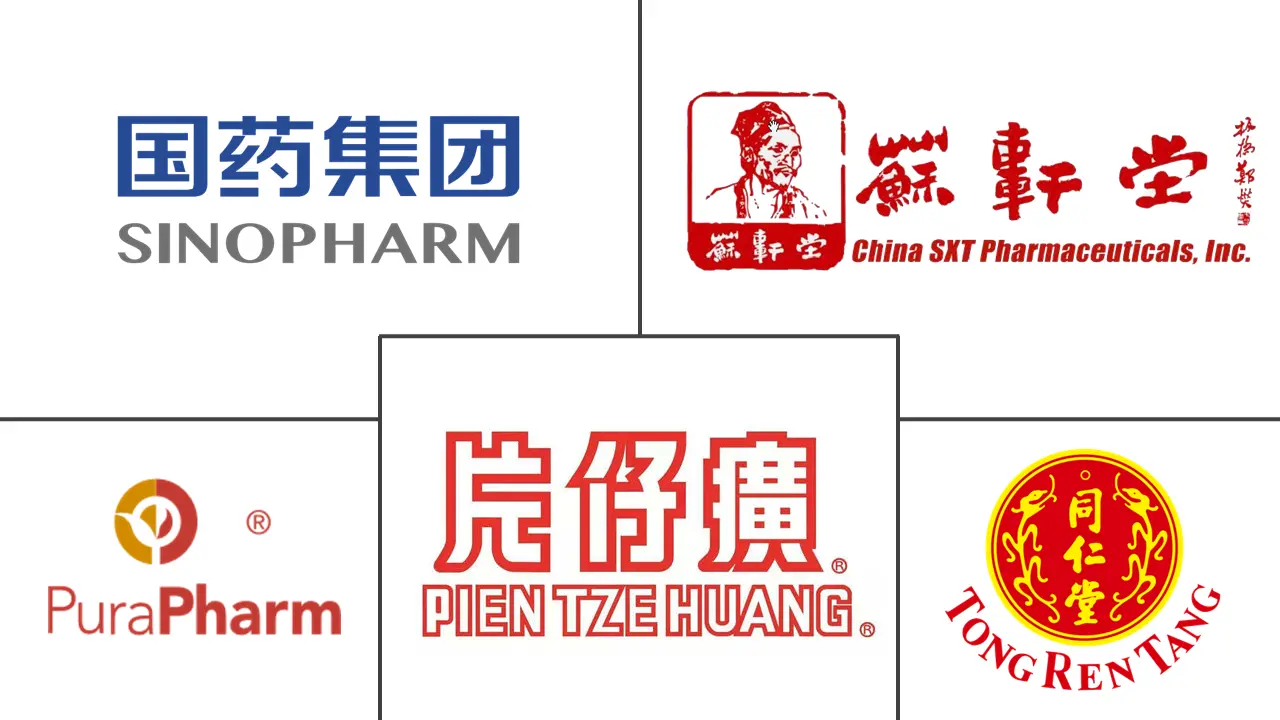
*Disclaimer: Major Players sorted in no particular order |
Traditional Chinese Medicine Market Analysis
The Traditional Chinese Medicine Market size is estimated at USD 80.36 billion in 2024, and is expected to reach USD 115.83 billion by 2029, growing at a CAGR of 7.59% during the forecast period (2024-2029).
Key market drivers include the rising adoption of complementary and alternative medicine (CAM), technological advancements, heightened demand for traditional Chinese medicine (TCM) from developing nations, and an increasing awareness of the health benefits associated with natural remedies.
The global demand for TCM is set to surge, fueled by its rising adoption in treating ailments like osteoarthritis, weight management, and diabetes. This trend is anticipated to bolster the market throughout the forecast period.
For instance, a January 2024 article in the Patient Preference and Adherence Journal highlighted a study with 28,993 participants. It found that 34% turned to TCM for chronic ailments, 33% for general symptoms, 26.9% for rehabilitation, and 26.3% for sleep disorders. TCM a prominent form of CAM, enjoys widespread popularity as a health practice globally. Thus, its significant role in managing chronic conditions positions it as a key driver for the market's growth.
Moreover, technological strides in TCM are amplifying awareness of its health benefits, enhancing its efficacy and safety, and consequently boosting its adoption.
For example, in September 2022, BASF Corporation, a Chinese pharmaceutical giant, unveiled 'Phytocine'. This innovative line of TCMs, crafted using advanced skin biology and plants from China's Pan-Himalaya, targets skin ailments. Phytocine not only hydrates the skin but also fortifies its barrier and mitigates oxidative stress. Such advancements in TCM are poised to elevate its market presence.
In conclusion, while the rising adoption of CAM and technological innovations in TCM promise to propel the market, concerns surrounding efficacy and safety may pose challenges.
Traditional Chinese Medicine Market Trends
Cardiovascular Diseases Segment is Expected to Hold Significant Market Share Over the Forecast Period.
Traditional Chinese medicine (TCM), known for its body-strengthening effects, is increasingly being employed to address cardiovascular diseases. Among its various herbal formulations, Panax notoginseng stands out for its potent antioxidant properties and is commonly used to manage cardiovascular issues, including strokes.
Key drivers of the market include the surging prevalence of cardiovascular diseases, heightened research and development endeavors, and an expanding awareness of TCM's cardiovascular benefits.
The global uptick in cardiovascular diseases is propelling the adoption of TCM. This is not only to mitigate treatment side effects and enhance patient health but also to curtail overall treatment costs, thereby bolstering the market during the forecast period.
For instance, data from the British Heart Foundation in January 2024 highlighted that in 2023, around 7.6 million individuals in the UK were grappling with heart or circulatory diseases. Furthermore, the foundation noted that roughly 2.3 million of these were diagnosed with congestive heart disease (CHD).
In another instance, the Italian Society for Cardiovascular Prevention (Siprec) reported in May 2023 that Italy sees over 230 thousands cardiovascular cases annually. These cases incur healthcare costs ranging from EUR 19-24 billion (USD 20.56-25.97), with direct costs alone accounting for EUR 11-16 billion (USD 11.87-17.26). Such high prevalence and treatment costs amplify the demand for effective alternatives like TCM, subsequently boosting the segment's revenue during the forecast period.
Furthermore, the surge in research activities aimed at integrating TCM into cardiovascular treatments is poised to further propel the market.
For instance, an August 2023 article from the European Society of Cardiology spotlighted a pilot study involving 3,110 patients. Of these, 1,555 were administered qiliqiangxin, a TCM extract derived from 11 herbs, while the other half received a placebo. The findings underscored qiliqiangxin's efficacy in curbing hospitalizations for heart failure and reducing cardiovascular deaths in patients with heart failure and a reduced ejection fraction (HFrEF). The study noted qiliqiangxin's ability to lower N-terminal pro–B-type natriuretic peptide (NT-proBNP) levels and alleviate heart failure symptoms in HFrEF patients. Such promising clinical trial outcomes bolster the market's embrace of TCM, fueling its growth.
In conclusion, the escalating prevalence of cardiovascular diseases, coupled with intensified R&D efforts for TCM, is set to accelerate the segment's growth trajectory in the coming years.
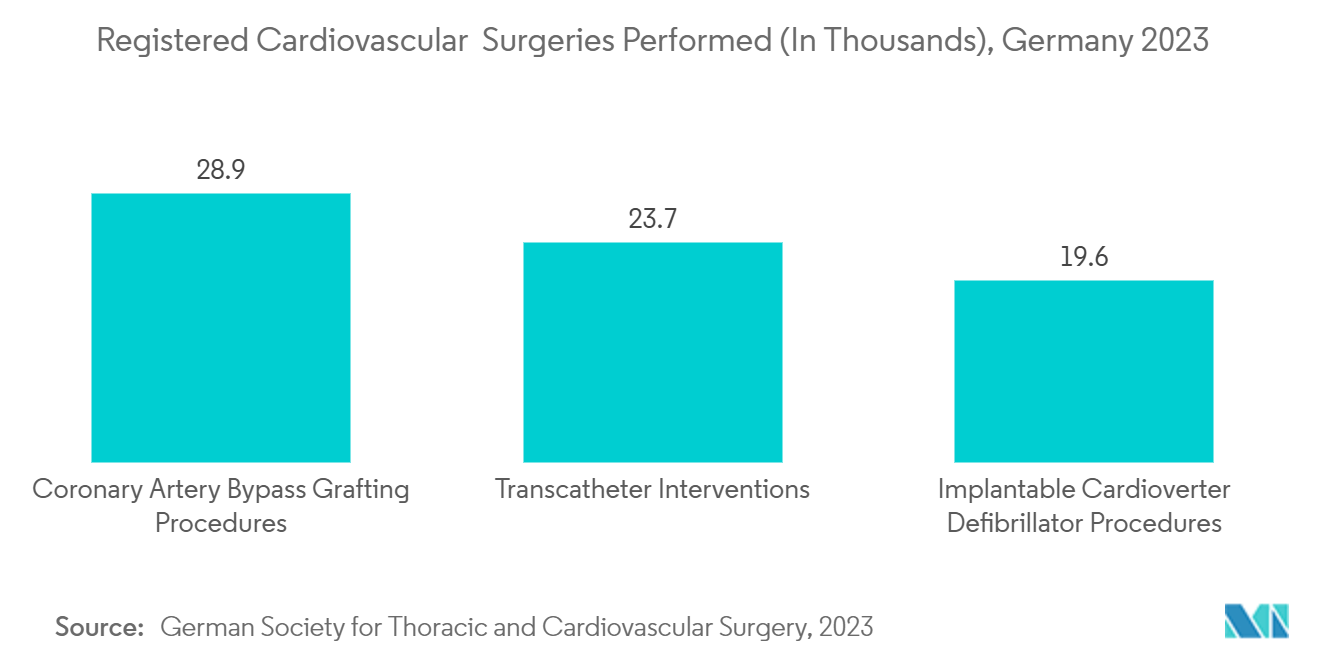
North America is Expected to Hold the Significant Market Share Over the Forecast Period
In North America, the traditional Chinese medicine market is fueled by the rising prevalence of chronic diseases, a growing acceptance of alternative medicine, expanding scientific research validating TCM's efficacy, and heightened awareness of its clinical benefits.
Due to its cost-effectiveness and fewer side effects, the adoption of alternative therapies like traditional Chinese medicine is set to bolster the market during the forecast period. For example, a January 2023 article in Lippincott highlighted a study of 1,016 U.S. women, revealing that about 67% used nonprescription medications, including TCM therapies, for menopausal hot flashes. Black cohosh emerged as the predominant herb for these symptoms.
Moreover, a December 2022 article in the Wolter Kluwer Journal noted that Canada's embrace of multiculturalism has facilitated the integration of TCM and acupuncture into its healthcare system. This blend of TCM and Western medicine has enriched patient care in Canada. Thus, the rising use of TCM for various ailments, including menopausal symptoms, is poised to propel the market forward.
Additionally, intensified research validating the safety and efficacy of TCM is anticipated to further boost its adoption, driving the market's growth.
For instance, an October 2023 article in the Journal of the American Medical Association (JAMA) discussed a clinical trial involving 3,777 patients with ST-segment elevation myocardial infarction (STEMI). The trial found that a 12-month oral regimen of Tongxinluo, a TCM, notably outperformed a placebo in reducing major cardiac and cerebrovascular events within 30 days (3.4% vs. 5.2%) and significantly lowered cardiac death rates. Such promising clinical trial outcomes bolster TCM's market adoption, fueling its growth.
In summary, as alternative medicine gains traction and scientific backing for TCM's efficacy grows, the utilization of traditional Chinese medicine is set to rise, propelling the North American market forward.
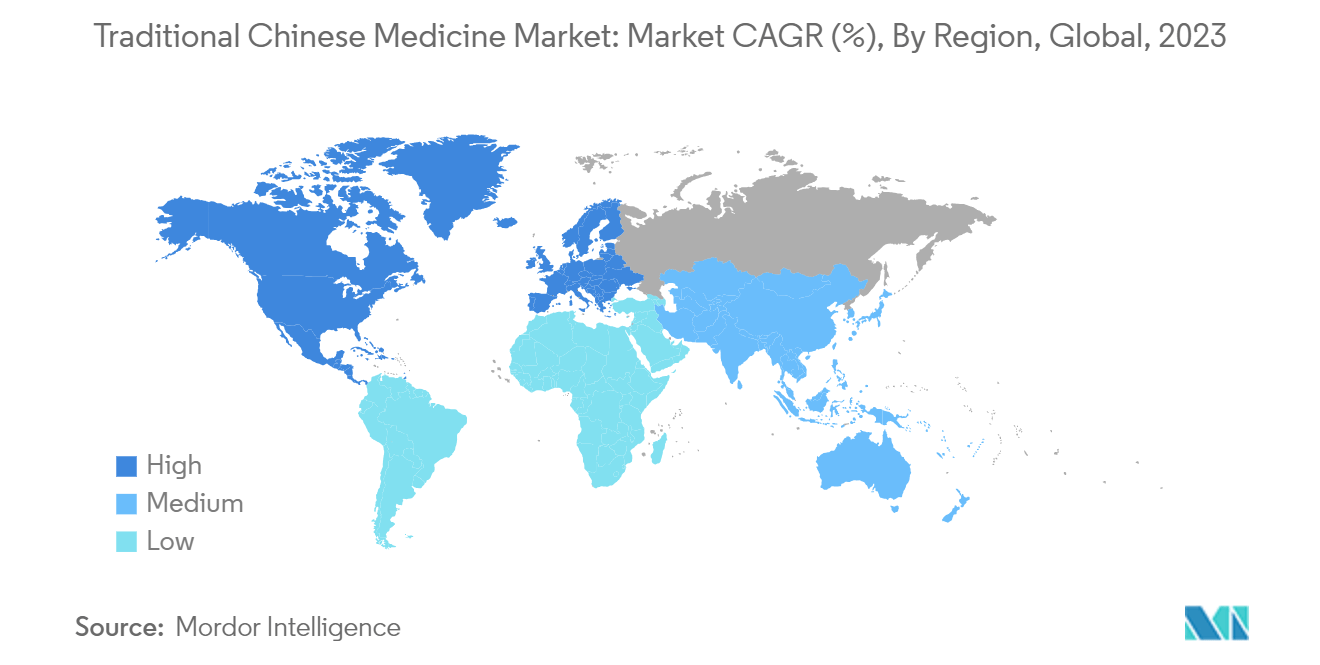
Traditional Chinese Medicine Industry Overview
The traditional Chinese medicine market is semi-consolidated, characterized by a mix of global and regional players. Major players are actively engaging in strategic maneuvers, including mergers, collaborations, and fundraising, all aimed at developing new solutions. Key players in the market include China National Pharmaceutical Group Co. Ltd., China SXT Pharmaceuticals, Inc., Beijing Tong Ren Tang Chinese Medicine Co. Ltd., PuraPharm International, and Zhangzhou Pien Tze Huang Pharmaceutical Co., Ltd.
Traditional Chinese Medicine Market Leaders
-
China National Pharmaceutical Group Co Ltd.
-
China SXT Pharmaceuticals, Inc
-
PuraPharm International
-
Zhangzhou Pien Tze Huang Pharmaceutical Co.,Ltd
-
Beijing Tong Ren Tang Chinese Medicine Co. Ltd.
*Disclaimer: Major Players sorted in no particular order
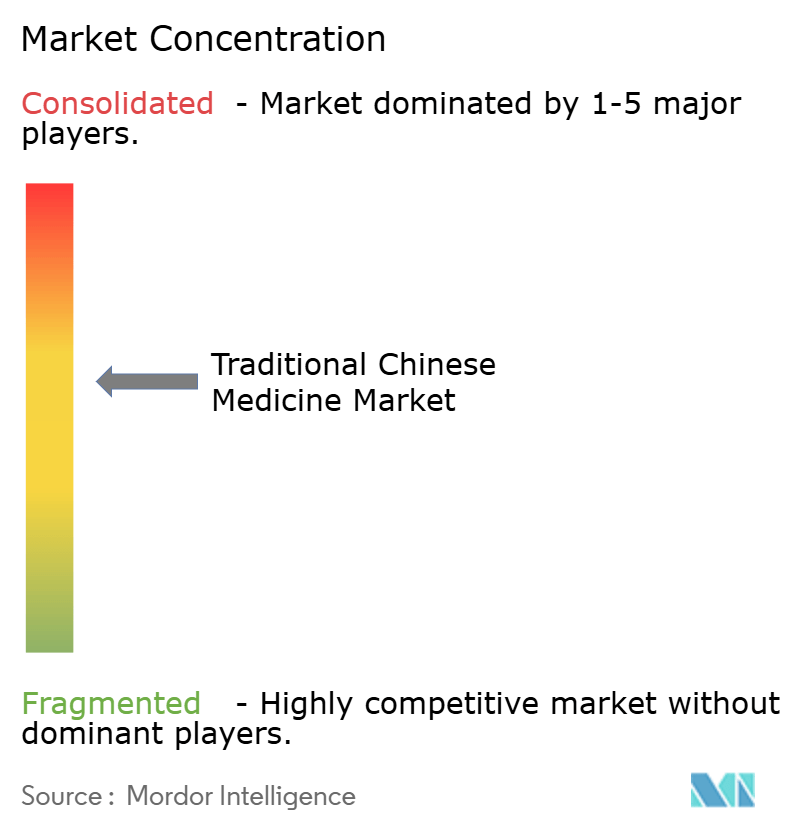
Traditional Chinese Medicine Market News
- April 2024: Rohto Pharmaceutical and Mitsui & Co. have acquired Eu Yan Sang International, a traditional Chinese medicine company, for SGD 800 million (USD 594 million). Eu Yan Sang International operates more than 170 stores and 30 Chinese herbal medicine clinics, primarily located in Malaysia, Hong Kong, and Singapore.
- February 2024: Sinopharm, a state-owned pharmaceutical company in China, has renewed its bid to take private China Traditional Chinese Medicine Holdings (China-TCM), a drug manufacturer listed in Hong Kong, with an offer valued at USD 3 billion.
Traditional Chinese Medicine Market Report - Table of Contents
1. INTRODUCTION
1.1 Study Assumptions and market definitions
1.2 Scope of the Study
2. RESEARCH METHODOLOGY
3. EXECUTIVE SUMMARY
4. MARKET DYNAMICS
4.1 Market Overview
4.2 Market Drivers
4.2.1 Rising Utilization of Complementary and alternative medicine
4.2.2 Growing Technological Advancements
4.3 Market Restraints
4.3.1 Concerns About Safety and Efficiency
4.4 Porter's Five Force Analysis
4.4.1 Threat of New Entrants
4.4.2 Bargaining Power of Buyers/Consumers
4.4.3 Bargaining Power of Suppliers
4.4.4 Threat of Substitute Products
4.4.5 Intensity of Competitive Rivalry
5. MARKET SEGMENTATION (Market Size by Value - USD)
5.1 By Therapy Type
5.1.1 Acupuncture
5.1.2 Cupping Therapy
5.1.3 Herbal Medicine
5.1.4 Aroma Therapy
5.1.5 Compounding Therapy
5.1.6 Magneto Therapy
5.2 By Application
5.2.1 Osteoarthritis
5.2.2 Cold and Flus
5.2.3 Menstrual Pain
5.2.4 Diabetes
5.2.5 Weight Loss
5.2.6 Others (Sexual Dysfunction in Men, Infertility in Women and Others)
5.3 By End User
5.3.1 Home Healthcare
5.3.2 Hospitals and Clinics
5.4 Geography
5.4.1 North America
5.4.1.1 United States
5.4.1.2 Canada
5.4.1.3 Mexico
5.4.2 Europe
5.4.2.1 Germany
5.4.2.2 United Kingdom
5.4.2.3 France
5.4.2.4 Italy
5.4.2.5 Spain
5.4.2.6 Rest of Europe
5.4.3 Asia-Pacific
5.4.3.1 China
5.4.3.2 Japan
5.4.3.3 India
5.4.3.4 Australia
5.4.3.5 South Korea
5.4.3.6 Rest of Asia-Pacific
5.4.4 Rest of the World
6. COMPETITIVE LANDSCAPE
6.1 Company Profiles
6.1.1 China National Pharmaceutical Group Co Ltd.
6.1.2 China SXT Pharmaceuticals, Inc
6.1.3 Merro Pharmaceutical Co., Ltd
6.1.4 Zhangzhou Pien Tze Huang Pharmaceutical Co.,Ltd
6.1.5 Tasly Holding Group
6.1.6 Zhengzhou Ruilong Pharmaceutical Co. Ltd.
6.1.7 Guangzhou Pharmaceutical Holdings Limited
6.1.8 Kangmei Pharmaceutical Co., Ltd.
6.1.9 Beijing Tong Ren Tang Chinese Medicine Co. Ltd.
6.1.10 Xiamen Traditional Chinese Medicine Co., Ltd.
6.1.11 KPC Pharmaceuticals, Inc
- *List Not Exhaustive
7. MARKET OPPORTUNITIES AND FUTURE TRENDS
Traditional Chinese Medicine Industry Segmentation
As per the scope of the report, traditional Chinese medicine practitioners use various psychological and physical approaches (such as acupuncture and tai chi) as well as herbal products to address various health problems. Traditional Chinese medicine is about creating bodily balance to maintain health and wellness. The traditional Chinese medicine market is segmented into therapy type, application, end-user, and geography. By therapy type, the market is segmented into acupuncture, cupping therapy, herbal medicine, aroma therapy, compounding therapy, and magneto therapy. By application, the market is segmented into osteoarthritis, cold and flu, menstrual pain, cardiovascular diseases, diabetes, and others (sexual dysfunction in men, infertility in women and others). By end-user, the market is segmented into hospitals and clinics, and home care settings. By geography, the market is segmented into North America, Europe, Asia-Pacific, and the Rest of the World. The report also covers the estimated market sizes and trends for 13 countries across significant global regions. The report offers the value (in USD) for the above segments.
| By Therapy Type | |
| Acupuncture | |
| Cupping Therapy | |
| Herbal Medicine | |
| Aroma Therapy | |
| Compounding Therapy | |
| Magneto Therapy |
| By Application | |
| Osteoarthritis | |
| Cold and Flus | |
| Menstrual Pain | |
| Diabetes | |
| Weight Loss | |
| Others (Sexual Dysfunction in Men, Infertility in Women and Others) |
| By End User | |
| Home Healthcare | |
| Hospitals and Clinics |
| Geography | ||||||||
| ||||||||
| ||||||||
| ||||||||
| Rest of the World |
Traditional Chinese Medicine Market Research FAQs
How big is the Traditional Chinese Medicine Market?
The Traditional Chinese Medicine Market size is expected to reach USD 80.36 billion in 2024 and grow at a CAGR of 7.59% to reach USD 115.83 billion by 2029.
What is the current Traditional Chinese Medicine Market size?
In 2024, the Traditional Chinese Medicine Market size is expected to reach USD 80.36 billion.
Who are the key players in Traditional Chinese Medicine Market?
China National Pharmaceutical Group Co Ltd., China SXT Pharmaceuticals, Inc, PuraPharm International, Zhangzhou Pien Tze Huang Pharmaceutical Co.,Ltd and Beijing Tong Ren Tang Chinese Medicine Co. Ltd. are the major companies operating in the Traditional Chinese Medicine Market.
Which is the fastest growing region in Traditional Chinese Medicine Market?
North America is estimated to grow at the highest CAGR over the forecast period (2024-2029).
Which region has the biggest share in Traditional Chinese Medicine Market?
In 2024, the Asia Pacific accounts for the largest market share in Traditional Chinese Medicine Market.
What years does this Traditional Chinese Medicine Market cover, and what was the market size in 2023?
In 2023, the Traditional Chinese Medicine Market size was estimated at USD 74.26 billion. The report covers the Traditional Chinese Medicine Market historical market size for years: 2019, 2020, 2021, 2022 and 2023. The report also forecasts the Traditional Chinese Medicine Market size for years: 2024, 2025, 2026, 2027, 2028 and 2029.
Traditional Chinese Medicine Industry Report
Statistics for the 2024 Traditional Chinese Medicine market share, size and revenue growth rate, created by Mordor Intelligence™ Industry Reports. Traditional Chinese Medicine analysis includes a market forecast outlook for 2024 to 2029 and historical overview. Get a sample of this industry analysis as a free report PDF download.



